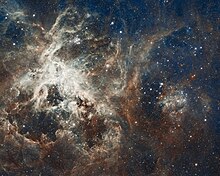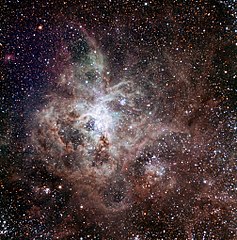Mgławica Tarantula
(c) TRAPPIST/E. Jehin/ESO, CC BY 4.0 Mgławica Tarantula (ESO) | |
| Odkrywca | |
|---|---|
| Data odkrycia | 5 grudnia 1751 |
| Dane obserwacyjne (J2000) | |
| Gwiazdozbiór | |
| Typ | |
| Rektascensja | 05h 38m 36,0s[1] |
| Deklinacja | –69° 05′ 11″[1] |
| Odległość | |
| Jasność pozorna mgławicy | 8m |
| Rozmiary kątowe | 40' × 25' |
| Charakterystyka fizyczna | |
| Wymiary | 1000 ly |
| Alternatywne oznaczenia | |
| NGC 2070, 30 Doradus, ESO 57-EN6, LHA 120-N 157A | |
Mgławica Tarantula (również NGC 2070, 30 Doradus) – wielka mgławica (obszar H II) w Wielkim Obłoku Magellana. Znajduje się w konstelacji Złotej Ryby. Mgławica Tarantula po raz pierwszy została skatalogowana jako gwiazda 30 Doradus. 5 grudnia 1751 roku Nicolas-Louis de Lacaille uznał ją za mgławicę. Nazwa Tarantula nawiązuje do tego, że jej świetliste włókna przypominają nogi pająka[2].

Jej średnica kątowa 20' na niebie odpowiada w rzeczywistości około 1000 lat świetlnych. Masa mgławicy jest równa co najmniej 3000 mas Słońca. Mgławica Tarantula ma widomą wielkość gwiazdową 8, co przy odległości mgławicy (c.a. 170 000 – 179 000 lat świetlnych) oznacza bardzo jasny obiekt[3][4]. Gdyby obiekt ten znajdował się w takiej odległości od Ziemi jak Mgławica Oriona (1300 lat świetlnych), to na ziemskim niebie rozciągałby się na szerokość kątową 60 Księżyców i byłby na tyle jasny, aby w nocy rzucać cień[5].
Jest to najbardziej aktywny obszar gwiazdotwórczy w całej Grupie Lokalnej. W centrum mgławicy znajduje się młoda gromada masywnych gwiazd skatalogowana jako R136. To właśnie intensywne promieniowanie i silny wiatr pochodzące z tej gromady tworzą poświatę mgławicy oraz kształtują jej włókna. Znajdujący się w mgławicy gaz poprzez owe wiatry oraz wybuchy supernowych został podgrzany do temperatury milionów stopni, stając się źródłem promieniowania rentgenowskiego.
Mgławica Tarantula zawiera także inne młode gromady gwiazd, jak również ciemne obłoki, rozciągnięte i postrzępione włókna gazu, zwarte mgławice emisyjne, niemal sferyczne pozostałości po supernowych oraz superbąble otaczające gorące gwiazdy. Na obrzeżach mgławicy znajduje się w niej również najbliższa od czasów odkrycia teleskopu supernowa – SN 1987A.
Zobacz też
- Hodge 301 – gromada gwiazd w Mgławicy Tarantula
Przypisy
- ↑ a b Mgławica Tarantula w bazie SIMBAD (ang.)
- ↑ Nowy obraz mgławicy Tarantula wykonany przez Hubble, Chandrę i Spitzera. tłumaczenie: NASA Chandra, 2012-04-17. [dostęp 2012-04-18].
- ↑ NGC 2070 – Mgławica Tarantula, astronomia.hekko.pl [dostęp 2016-02-10] [zarchiwizowane z adresu 2016-02-17].
- ↑ Hartmut Frommert, Christine Kronberg, NGC 2070, the Tarantula Nebula (30 Doradus), messier.seds.org [dostęp 2016-02-10].
- ↑ Drama In The Heart Of The Tarantula Nebula. Science Daily, 2008-12-11. [dostęp 2008-12-13]. (ang.).
Linki zewnętrzne
- Mgławica Tarantula w bazie SIMBAD (ang.)
- 30 Doradus na HubbleSite (ang.)
Media użyte na tej stronie
Several million young stars are vying for attention in this NASA Hubble Space Telescope image of a raucous stellar breeding ground in 30 Doradus, located in the heart of the Tarantula Nebula. Early astronomers nicknamed the nebula because its glowing filaments resemble spider legs.
30 Doradus is the brightest star-forming region visible in a neighboring galaxy and home to the most massive stars ever seen. The nebula resides 170,000 light-years away in the Large Magellanic Cloud, a small, satellite galaxy of our Milky Way. No known star-forming region in our galaxy is as large or as prolific as 30 Doradus.
The composite image comprises one of the largest mosaics ever assembled from Hubble photos and includes observations taken by Hubble's Wide Field Camera 3 and Advanced Camera for Surveys. The Hubble image is combined with ground-based data of the Tarantula Nebula, taken with the European Southern Observatory's 2.2-meter telescope in La Silla, Chile. NASA and the Space Telescope Science Institute are releasing the image to celebrate Hubble's 22nd anniversary.
Collectively, the stars in this image are millions of times more massive than our Sun. The image is roughly 650 light-years across and contains some rambunctious stars, from one of the fastest rotating stars to the speediest and most massive runaway star.
The nebula is close enough to Earth that Hubble can resolve individual stars, giving astronomers important information about the stars' birth and evolution. Many small galaxies have more spectacular starbursts, but the Large Magellanic Cloud's 30 Doradus is one of the only extragalactic star-forming regions that astronomers can study in so much detail. The star-birthing frenzy in 30 Doradus may be partly fueled by its close proximity to its companion galaxy, the Small Magellanic Cloud.
The image reveals the stages of star birth, from embryonic stars a few thousand years old still wrapped in cocoons of dark gas to behemoths that die young in supernova explosions. 30 Doradus is a star-forming factory, churning out stars at a furious pace over millions of years. Hubble shows star clusters of various ages, from about 2 million to about 25 million years old.
The region's sparkling centerpiece is a giant, young star cluster (left of center) named NGC 2070, only 2 million years old. Its stellar inhabitants number roughly 500,000. The cluster is a hotbed for young, massive stars. Its dense core, known as R136, is packed with some of the heftiest stars found in the nearby universe, weighing more than 100 times the mass of our Sun.
The massive stars are carving deep cavities in the surrounding material by unleashing a torrent of ultraviolet light, which is etching away the enveloping hydrogen gas cloud in which the stars were born. The image reveals a fantasy landscape of pillars, ridges, and valleys. Besides sculpting the gaseous terrain, the brilliant stars also may be triggering a successive generation of offspring. When the radiation hits dense walls of gas, it creates shocks, which may be generating a new wave of star birth.
The colors represent the hot gas that dominates regions of the image. Red signifies hydrogen gas and blue, oxygen.
Hubble imaged 30 separate fields, 15 with each camera. Both cameras were making observations at the same time. Hubble made the observations in October 2011.(c) TRAPPIST/E. Jehin/ESO, CC BY 4.0
This first light image of the TRAPPIST national telescope at La Silla shows the Tarantula Nebula, located in the Large Magellanic Cloud (LMC) — one of the galaxies closest to us. Also known as 30 Doradus or NGC 2070, the nebula owes its name to the arrangement of bright patches that somewhat resembles the legs of a tarantula. Taking the name of one of the biggest spiders on Earth is very fitting in view of the gigantic proportions of this celestial nebula — it measures nearly 1000 light-years across! Its proximity, the favourable inclination of the LMC, and the absence of intervening dust make this nebula one of the best laboratories to help understand the formation of massive stars better. The image was made from data obtained through three filters (B, V and R) and the field of view is about 20 arcminutes across.
To celebrate its 22nd anniversary in orbit, the Hubble Space Telescope released a dramatic new image of the star-forming region 30 Doradus, also known as the Tarantula Nebula because its glowing filaments resemble spider legs. A new image from all three of NASA's Great Observatories--Chandra, Hubble, and Spitzer--has also been created to mark the event.
The nebula is located in the neighboring galaxy called the Large Magellanic Cloud, and is one of the largest star-forming regions located close to the Milky Way. At the center of 30 Doradus, thousands of massive stars are blowing off material and producing intense radiation along with powerful winds. The Chandra X-ray Observatory detects gas that has been heated to millions of degrees by these stellar winds and also by supernova explosions. These X-rays, colored blue in this composite image, come from shock fronts--similar to sonic booms--formed by this high-energy stellar activity.
The Hubble data in the composite image, colored green, reveals the light from these massive stars along with different stages of star birth, including embryonic stars a few thousand years old still wrapped in cocoons of dark gas. Infrared emission data from Spitzer, seen in red, shows cooler gas and dust that have giant bubbles carved into them. These bubbles are sculpted by the same searing radiation and strong winds that comes from the massive stars at the center of 30 Doradus.



